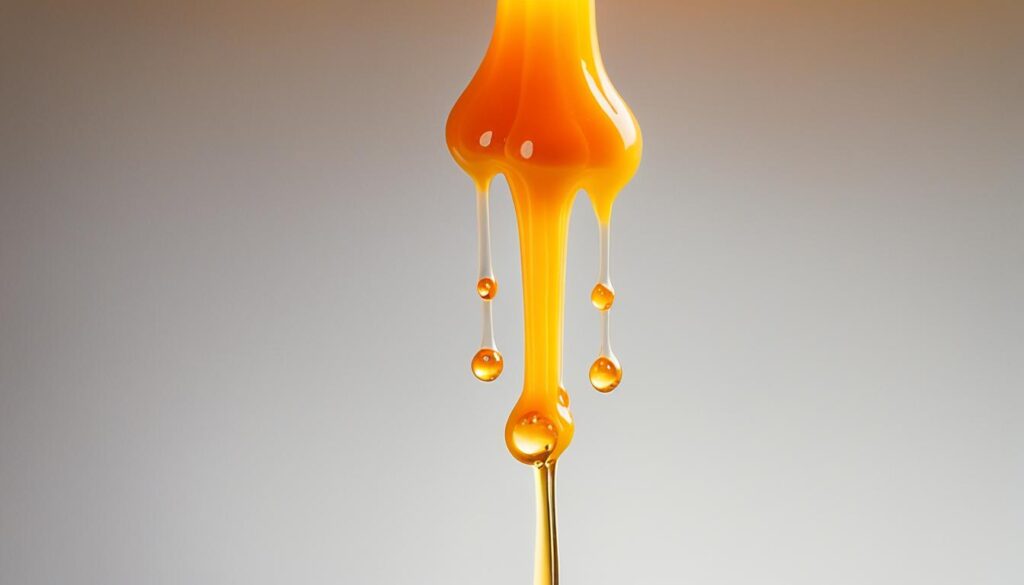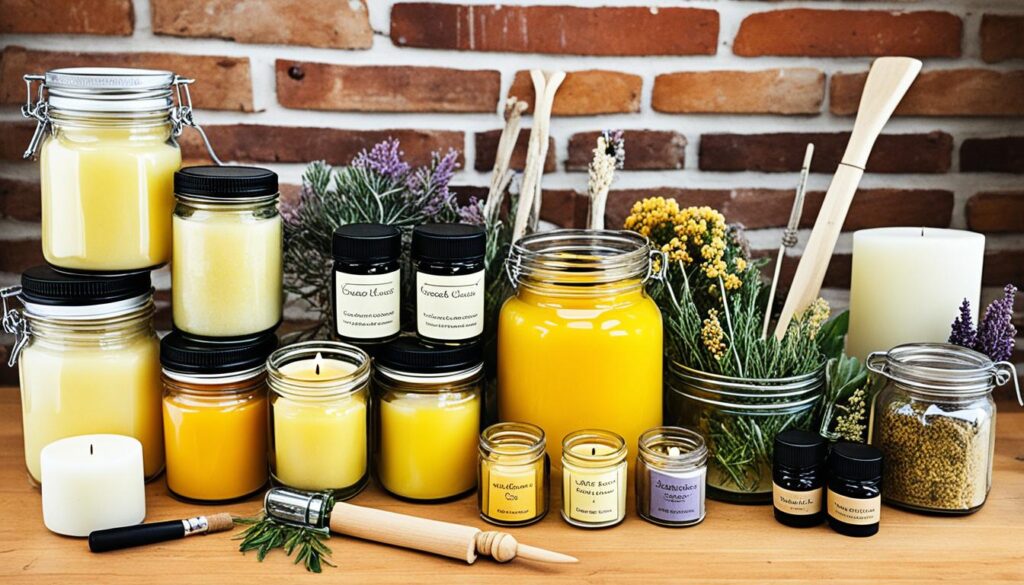The Complete Guide to Natural Candle Making: Tips and Techniques
Imagine your home filled with the soft, warm light of candles made from pure, natural stuff – no harsh chemicals or fake smells. Welcome to the world of natural candle making. Here, you can make beautiful, eco-friendly candles that make any space feel special. But have you ever thought, What makes natural candle making special, and how can I get better at it?
This guide is your key to learning about natural candle making. It will give you the skills to make your home a place of calm light and lovely smells. You’ll learn about the perks of making your own candles and how to pick the best waxes, scents, and colors. This journey will spark your creativity and make you appreciate the beauty of living naturally.
Key Takeaways
- Discover the advantages of choosing natural, eco-friendly candle making over conventional options.
- Explore the diverse range of natural waxes and learn how to select the best ones for your candle projects.
- Master the art of blending fragrances and essential oils to create your own unique, aromatic candle creations.
- Uncover natural coloring techniques that will add visual interest and personalization to your candles.
- Dive into step-by-step instructions for successfully melting, pouring, and cooling your natural candles.
Introduction to Natural Candle Making
Candle making is a fun and creative hobby. You can make candles that match your style and preferences. By choosing natural candle making, you use non-toxic, sustainable materials. This is better for the environment and your health.
Why Choose Natural Candle Making?
Natural candles burn cleaner and produce less soot. They also last longer than regular candles. Making your own candles lets you control the ingredients. This makes for a safer and more personal candle experience.
Handmade candles are a great choice for those looking for eco-friendly options. They offer many benefits over store-bought candles.
Benefits of Handmade Natural Candles
Making your own natural candles at home has many perks. They burn cleaner and last longer than store-bought ones. The process can be calming and fulfilling, letting you express your creativity.
Handmade candles let you avoid harmful chemicals and synthetic fragrances. You can customize the scent, color, and design to match your taste and decor. Enjoying the benefits of natural candles can be very rewarding.
Essential Supplies for Natural Candle Making
When making your own natural candles, having the right supplies is key. You need to pick the right waxes, wicks, and containers. Each part is important for the quality and how well your candles work.
Types of Natural Waxes
People are moving away from paraffin wax to more eco-friendly options. Soy wax is a great choice because it’s renewable and burns cleaner. It also has a better scent than paraffin.
Beeswax is another great option. It’s natural and gives a bright flame and a sweet smell. It’s perfect for candles without scents.
Wicks and Candlewick Holders
Choosing the right wick is crucial for a clean burn. You can pick from cotton, paper-cored, and wooden wicks. Cotton wicks are popular for their steady burn. Paper-cored wicks last a bit longer, and wooden wicks crackle for a special look.
Make sure to pick the right wick size for your candle. You’ll also need a wick holder or tab to keep the wick in place while making the candle.
Containers and Molds
The container or mold you use affects your candle’s look and performance. You can use glass jars, ceramic pots, or even old containers for container candles. These let you see the wax and any colors or inclusions.
For pillar or freestanding candles, use candle molds made of silicone or metal. Think about size, shape, and heat resistance when picking containers or molds for a good candle-making experience.
Choosing the Right Natural Wax
Choosing the best natural wax for candle-making is both exciting and a bit overwhelming. Soy wax and beeswax are top choices, each with its own benefits. Knowing what to look for in natural wax can help you pick the right one for your needs.
Soy wax is a top pick for its eco-friendly qualities. It’s renewable, biodegradable, and vegan-friendly. It also has a clean burn, throws scent well, and has a lower melting point than other waxes. Beeswax, on the other hand, is a natural wax that gives a brighter flame and a sweet smell. It’s perfect for candles without added scents, letting the wax’s natural beauty shine.
| Soy Wax | Beeswax |
|---|---|
| Renewable, biodegradable, vegan-friendly | Natural, hard wax with a brighter flame |
| Clean burn, good scent throw | Slightly sweet aroma, great for unscented candles |
| Lower melting point, easier to work with | Harder and more durable, longer burn time |
When deciding between soy wax and beeswax, think about burn time, scent, the environment, and what you like. Weighing these factors helps you pick the best natural wax for your candle-making goals. This way, you can make candles that are both beautiful and kind to the planet.
Selecting Fragrances and Essential Oils
Adding fragrance to your natural candles can make the experience even better. When picking fragrances, choose essential oils or candle-making fragrance oils. These are made to work well with wax. Don’t use perfumes or colognes because they might have flammable parts that could be dangerous.
Calculating Fragrance Load
Start with a 6-10% fragrance oil per pound of wax for your candles. This amount gives a strong scent without overpowering the wax’s natural smell. Try different ratios and note the results to find your perfect fragrance strength.
Blending Fragrance Oils
You can mix essential oils and fragrance oils to make unique scents for your candles. Mixing different smells creates a more interesting fragrance. Try combining floral with earthy or citrus scents, or mix calming lavender with refreshing peppermint. Play with different mixes to find your special scent. Keeping track of your blends and how they smell will help you improve your candle-making skills.
| Fragrance Oil | Scent Profile | Suggested Blending Partners |
|---|---|---|
| Lavender | Floral, calming | Cedarwood, bergamot, ylang-ylang |
| Lemongrass | Citrus, energizing | Ginger, eucalyptus, peppermint |
| Sandalwood | Earthy, grounding | Vanilla, jasmine, frankincense |
“The art of blending fragrances is like composing a symphony – each note must harmonize to create a captivating, well-balanced aroma.”
Natural Candle Coloring Techniques
Enhancing your natural candles can be a fun and creative process. Instead of using synthetic dyes, try natural candle coloring methods that are good for the planet and look great. Learn how to use plant-based pigments for candles and eco-friendly candle dyes from nature.
Using Natural Dyes and Pigments
Use natural dyes and pigments to add earthy tones and calming shades to your candles. These colors come from plants and can change the look of your candles. They give your candles unique and beautiful colors that match the natural feel of your creations.
- Turmeric for golden and warm tones
- Alkanet root for shades of blue and purple
- Spirulina for vibrant green hues
- Beets for rich, ruby-red shades
- Activated charcoal for deep, smoky grays
These natural candle coloring methods can be added to the melted wax or used on the candle’s surface. This lets you try different colors and be creative. Let nature’s colors show in your handcrafted candles.
“The true secret of happiness lies in taking a genuine interest in all the details of daily life.”
Step-by-Step Guide to Making Natural Candles
Melting and Preparing the Wax
To start making natural candles, melt and prepare the wax first. Use a double-boiler by placing the wax in a heat-proof bowl over simmering water. This method ensures the wax, like soy wax or beeswax, melts evenly without overheating.
Heat the wax to a temperature between 158°F and 175°F. Use a thermometer to check the temperature. Don’t let it go above 200°F, as it can ruin the wax’s quality and performance. Once it’s fully melted, you can add fragrances, colorants, or other additives as desired.
Pouring and Cooling Techniques
Next, pour the melted wax into your containers or molds. Do this slowly to avoid air bubbles and uneven surfaces. Make sure there’s at least 1/2 inch of space at the top for the wick and shrinkage later.
Let the candles cool and harden naturally, away from drafts or sunlight. This slow cooling is key for a smooth finish. Don’t rush it, as quick cooling can cause cracking or frosting.

By carefully melting, preparing, pouring, and cooling the wax, you can make great homemade candles. This approach helps avoid common problems during candle making.
Troubleshooting Common Issues
Making natural candles can be rewarding, but you might face some challenges. Don’t worry! With the right tips, you can fix common problems and enjoy your handmade candles.
Preventing Frosting and Cracking
Frosting or crystallization on your candle’s surface is a common issue. It can happen due to quick cooling, wrong temperature, or some additives. To avoid this, heat your wax right and let the candles cool slowly and evenly.
Cracking can also happen if your candles cool too fast or have too many additives. Keep your room at a steady temperature and cool your candles slowly. This way, you can troubleshoot tips for natural candle making and solve issues like frosting and cracking.
“With a little patience and the right adjustments, you can avoid candle problems and create stunning, long-lasting natural candles.”
The journey of making natural candles is about learning and trying new things. By knowing the common issues and fixing them, you’ll get better at making how to avoid candle problems. Enjoy the art of natural candle making fully.
Natural Candle Making Safety Tips
When making your own natural candles, safety comes first. Follow key guidelines to enjoy the process safely. Here are some candle safety guidelines and precautions for making natural candles. They will make you a pro at safe homemade candle practices.
First, make sure your work area is well-ventilated. This is key when working with hot wax. Use heat-resistant gloves to protect your hands. Keep an eye on the wax’s melting temperature. If it goes over 200°F, it’s a fire risk, so watch the heat closely.
- Make sure your wicks are in the middle and cut to 1/4 to 1/2 inch before lighting. This helps prevent burning unevenly and flare-ups.
- Have a fire extinguisher ready, and never leave a burning candle alone. Always watch the candle, even if it seems calm.
- After making candles, store wax, fragrance oils, and supplies in a cool, dry place away from flames or heat. This prevents fires and keeps your materials safe.
Follow these key safety tips to safely make natural candles. You’ll be able to create beautiful, fragrant candles for your home.
“Safety first, creativity second. Never risk safety when making candles.”
The journey of making natural candles should be fun and rewarding. With some preparation and safety awareness, you can make truly remarkable, non-toxic candles. These will not only please your senses but also those of your family and friends.
Natural Candle Making
Making your own homemade natural candles at home is rewarding and eco-friendly. By making DIY eco-friendly candles, you can create unique candles that match your style and values. You control the materials, scents, and design, making it safer and more personal.
Choosing natural, sustainable ingredients is a big plus of making your own candles. Unlike store-bought candles, which may have synthetic fragrances and chemicals, homemade natural candles use pure essential oils and natural waxes. This means a cleaner burn and supports eco-friendly values.
Making DIY eco-friendly candles can be calming and creative. Melting wax, pouring, and adding your personal touch can make you feel creative and accomplished. It’s a great activity for both experts and beginners in natural candle making.
“Handmaking your own candles allows you to create a unique, personalized ambiance that reflects your style and values.”
Customizing Your Candles
Customizing your candles is a big part of the fun in natural candle making. You can pick the best natural wax and essential oils and design your candles’ shape and size. Try different techniques like layering colors or adding dried plants to make your homemade natural candles stand out.

Whether for your home or as gifts, making DIY eco-friendly candles is a fulfilling process. Embrace the art of making your own homemade natural candles and enjoy the many benefits of doing it yourself.
Creative Ideas for Natural Candle Gifts
Handmade natural candles are perfect for friends, family, and loved ones. You can make the gift even better with creative packaging and presentation. Use vintage jars, tins, or unique containers for your natural candle gift ideas. Add natural elements like dried flowers, leaves, or twine for a rustic look.
You can also wrap the candles in decorative boxes or bags. Add personalized tags or labels to show you care. This way, your natural candles become special gifts that highlight your creativity and thoughtfulness.
Creative Presentation for DIY Candles
Here are some ideas to make your natural candle gift ideas stand out:
- Repurpose vintage jars, tins, or unique containers as the candle holders
- Adorn the containers with natural elements like dried flowers, leaves, or twine
- Wrap the candles in decorative boxes or bags, adding personalized tags or labels
- Create custom gift sets by pairing the candle with complementary items like a cozy throw blanket or a set of gourmet tea
- Present the candle in a rustic wooden crate or on a decorative tray for a visually striking display
By focusing on presentation, you can turn your handmade natural candles into unique gifts. These gifts will be treasured by the people who receive them.
Caring for and Maintaining Natural Candles
To keep your handcrafted natural candles looking great, follow some simple care tips. Make sure to store them right, trim the wick, and control how long you burn them. These steps will help your candles last longer and stay beautiful.
Wick Trimming and Burn Times
Always trim the wick of your natural candles to 1/4 to 1/2 inch before lighting. This stops them from smoking too much or getting sooty. Don’t burn your candles for over 4 hours at once, and never leave one burning by itself.
Proper Storage for Natural Candles
Keep your unlit natural candles in a cool, dry spot out of the sun. This keeps them from getting discolored or losing their scent. Storing them right is crucial for their longevity.
Restoring Candle Surfaces
If your candles have frosting or cracks, you can fix them easily. Just reheat and re-pour the wax for a smooth look again. This trick can make your homemade candles look new.
- Trim wicks to 1/4 – 1/2 inch before lighting
- Avoid burning for more than 4 hours at a time
- Store candles in a cool, dry place away from sunlight
- Reheat and re-pour wax to fix surface imperfections
Follow these easy care tips to get the most out of your homemade natural candles. With the right storage and use, they’ll keep lighting up your space for years.
Conclusion
Natural candle making is a fun and green hobby. It lets you make candles that are just right for your home or as gifts. Using natural waxes, essential oils, and plant colors makes your candles clean-burning and long-lasting.
In this guide, you’ve learned all about making natural candles. You know how to pick the best wax and wick and add fragrance and color. You’ve also found out how to fix common problems and keep your candles safe and lasting longer.
Whether you’re just starting or you’re already good at crafting, natural candle making is a great way to add warmth and style to your home. With what you’ve learned, you can start your own DIY candle craft project. You’ll enjoy the benefits of making your own natural candles and be able to share them with loved ones.
FAQ
What are the benefits of choosing natural candle making?
What types of natural waxes are commonly used for candle making?
How do I choose the right wick for my natural candles?
What are some tips for incorporating fragrance into natural candles?
How can I add color to my natural candles?
What are some common issues I might encounter with natural candle making, and how can I prevent them?
What safety precautions should I take when making natural candles at home?
Source Links
- https://kalamazoocandle.com/blogs/learn-about-candles/candle-making-tips-tricks – 15 Candle Making Tips and Tricks (For Beginners)
- https://abeautifulmess.com/how-to-make-candles-beginners-guide/ – How to Make Candles
- https://www.alphafoodie.com/candle-making-for-beginners/ – Candle Making for Beginners
- Fragrance That Wows: A Beginner’s Guide to Adding Scents to Your Homemade Candles
- best essential oils for candles
- wood wick guide
- how to make candles smell stronger
- how to ship candles
- how to fix soy wax frosting
- wick Guide how to choose the right wick size with chart
- how to make candle molds
- how to clean candle wax
- how to reuse candle jars
- soy wax candle troubleshooting
- best wax melter for candle making
- how to conduct burn test
- why candle flickering crackling smoking
- how much wax per candle
- how to make candles smell stronger
- Easy Ways to Increase the Scent Throw of Your DIY Candles
- How to Make Candles for Meditation and Relaxation
- Using Upcycled Materials in Candle Making
- How to Make Hand-Poured Candles: Tips and Techniques

Leave a Reply